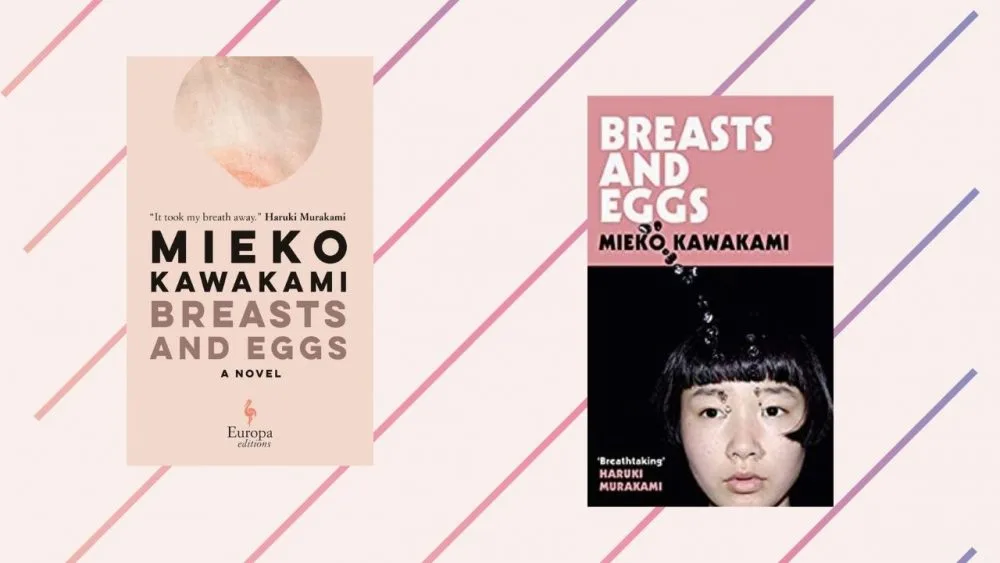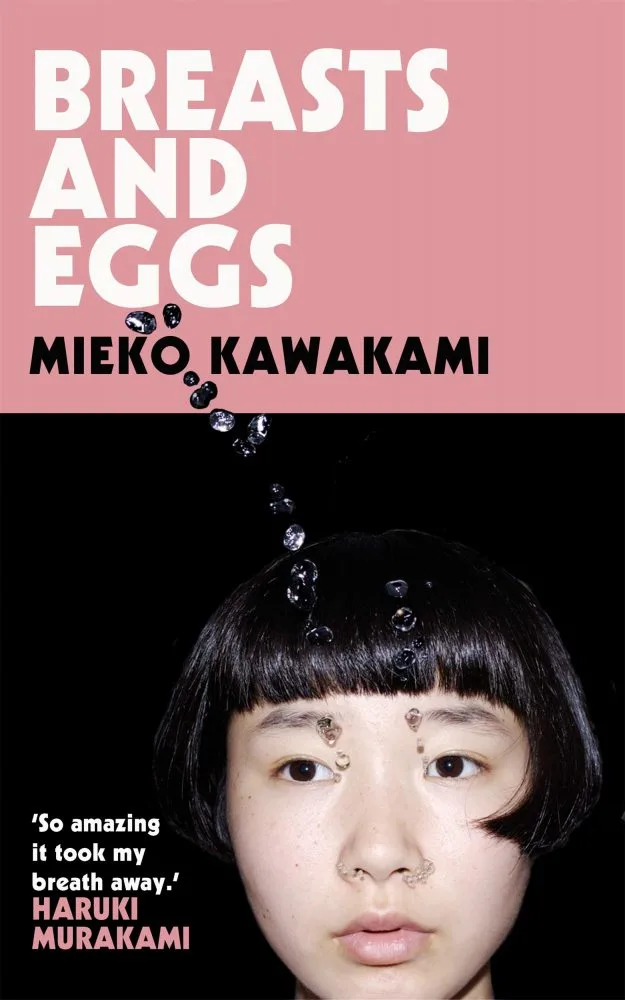Translated from the Japanese by Sam Bett & David Boyd
Mieko Kawakami is already a superstar author in her native Japan. A philosophical and feminist powerhouse of beautiful prose, interwoven with discussions on death, birth, womanhood, growth, and change.
She is now a rising star in the English language, too, thanks to translations of works like Ms. Ice Sandwich from Pushkin Press (tr. Louise Heal Kawai) and, now, Breasts and Eggs from Picador (tr. Sam Bett and David Boyd) and Europa Additions.
In its original Japanese publication, Breasts and Eggs was a novella. This expanded version, split into Book One and Book Two and translated into English by Sam Bett and David Boyd, is about three times longer, with Book Two being twice the length of Book One.

In Book One, we see the world through the eyes of Natsuko, a thirty-year-old woman living alone in a Tokyo apartment and working tirelessly in her spare time to become an author.
The story follows a weekend visit from her older sister, Makiko, who brings along her young teenage daughter Midoriko. Makiko’s main reason for visiting Tokyo from Osaka is not really to see her sister so much as it is to consult a plastic surgeon about breast enhancements.
Midoriko has, for several months now, been entirely mute around her mother, writing her notes if she has to communicate, and otherwise writing in her journal (much of which we get to read) and reportedly behaving completely ordinarily when at school.
The dichotomy between Makiko and her daughter is the crux of Book One, both in terms of story and theme. Breasts and Eggs couldn’t be a more clear and direct name for this book, with Makiko entirely obsessed with her own breasts and trying to make them more aesthetic, more desirable ‚ at least, by her own definition.
Meanwhile, Midoriko’s journal betrays her fear and outrage at the concept and the biology of womanhood, and how it defines the modern woman. Midoriko scrawls with white hot aggression about menstruation, breast growth, and child bearing.
Sperm, eggs, sex, procreation, all of these things trigger in her a reaction of disgust and hate, and this hate has spilled out, leaving her literally speechless in the face of her mother’s obsession with breast enhancement. Midoriko doesn’t understand gender roles and why biology controls us; or, rather, she understands it perfectly well and yet feels such hatred towards it.
She will not be controlled by her biology and the fact that she cannot control it in turn — such as stopping her breasts from growing or her periods from happening — is crushing for her. As a reader who is progressively identifying with, and adhering to, their own gender less and less, this resonated with me in a loud and powerful way.
The flipside of this is, of course, Makiko. She wishes for her dark nipples to be pinker and her small breasts to be larger. She brings up, several times, the fact that she had a child as the reason for her physical imperfections.
She is searching for an ideal of feminine beauty as she is about to turn forty. She is stuck in a job in which she is sexualised and put on display, and this lifelong position has had an almost degenerative effect on her psyche, which, in turn, has affected her increasingly angry and rebellious daughter.

Amidst all of this is Natsuko, who watches it all unfold from a place of relative calm and quiet. Natsuko is well defined in her own right but far less aggressively compelling as her sister and niece, which is an asset to the success of the story. Natsuko is grounded, though quietly sorrowful in her own way. She is a window into this world for us, but by no means a blank slate.
At 130 pages, Book One of Breasts and Eggs is a punk and angry scream in the face of beauty and gender politics; it is at once a broad examination of gender roles and beauty standards, and a kick to the guts of an oppressive yet passive system which silently tears women down and turns them against both themselves and each other.
Book Two is a very different beast, measuring twice the length of Book One and slowing its pace to reflect its protagonist’s age and emotional place in life. If Book One was a photograph or a haiku, Book Two is a film or a sonnet. We still follow Natsuko, but almost a decade has passed and she is now a published author.
Natsuko still lives in Tokyo, is still in touch with her sister and niece (though they exist only at the periphery this time around), and she has finally found herself where she wants to be: paid to read and to write full-time. Natsuko is far from satisfied, however. There is a slow, creeping need that is slowly closing in on her: to have a child of her own.
Natsuko has no desire for a man, has no real sexual desires (this is explored in intimate and curious ways), and yet she has this feeling that a child exists in her timeline; she simply has yet to meet them. She must find a way to reach the child she knows will eventually exist, and so she explores the option of artificial insemination. This is the driving force of the book’s narrative.
In her quest, she meets a handful of unique characters and also experiences a morphing of her current relationship, most notably that which she shares with her literary agent.
Read More: Review of Where the Wild Ladies Are by Matsuda Aoko
Book Two’s pace and progress is less deliberate and more ponderous, with Natsuko making little progress with her writing, and very slow progress in her search for her child.
There is a lot more breathing space here, with entire chapters made up of quiet conversations with people like Aizawa, a man who has been searching for his birth father for years; Rika, a single mother and fellow author who acts as a mentor and personal inspiration of sorts for Natsuko; Sengawa, Natsuko’s friend and agent; Yuriko, a woman who believes that forcing a child to be born is an act of cruelty, that nobody asks to be born and therefore it is tortuous and unfair.
The cast of characters which Natsuko surrounds herself with here each work like bumper cars for Natsuki to ricochet off; despite the crawling pace of Book Two, Natsuko nevertheless exists in a hurricane, occasionally knocked by an experience or conversation shared with Rika, Sengawa, or Aizawa.
Even though she is about to turn forty, Natsuko is still growing, changing, and learning. She meets death, suffers loss, finds herself floating and confused, seeks help, finds it, feels betrayed, learns, loses, finds, falls, stands up again.
In an interview with Hitomi Yoshio for Wasafiri Magazine, Kawakami discusses her philosophical approach to life and death, how she could never bring herself to sing ‘happy birthday’ as a child because, “I couldn’t get my head around the idea of celebrating birthdays when we were becoming one year closer to death and saying goodbye to our loved ones.”
This philosophical thinking, especially about the road from birth to death, certainly comes out in Breasts and Eggs. Most aggressively and vividly, it’s seen in the words of Yuriko, a character who exists almost as a philosophical plot device, obsessed as she is with the idea that giving birth is an unforgivably cruel act.
Yuriko’s philosophy is similar to that of real-world philosopher David Benetar, an anti-natalist who believes that, since life is so difficult and painful, we should not force our children to have to go through it themselves. Not every character is so directly philosophical, however; for most characters, it is their actions, and the way in which their words and behaviours affect Natsuko, which drive the plot.
Both Rika and Aizawa inspired and encourage Natsuko to consider, reconsider, and re-reconsider her approach to giving birth, raising a child, writing fiction, and simply how she looks at the passage of life and time. In Book One of Breasts and Eggs, Natsuko took on the role of the observer, with her sister and niece taking centre-stage.
In Book Two, Natsuko is our protagonist. But, even still, she is being batted about by her experiences and by the people who surround her. She moves from phone call to meeting to dinner date to phone call, always in conversation with someone, rarely alone unless she is on her way to meet someone.
This means we are always being offered a new perspective on life, motherhood, womanhood, work ethics, success, and more. This is perhaps the greatest thematic strength of Breasts and Eggs: perspectives on womanhood and motherhood. Mieko Kawakami explored womanhood in a visceral and agry way with Book One.
Book Two, on the other hand, offers us multiple stances, opinions, and ideas when it comes to carrying, giving birth, and raising a child. As well as the role of a woman in the family, in society, in the house.
Kawakami understands and expresses here that there is no one way to be a woman, no right way to live, no good or bad. That being a woman, a feminist, a mother, means doing things your way, unrestrained, with a view to feeling happy, contented, fulfilled. And she demonstrates this through the multiple – and multifaceted – lives of her characters.
Conclusion
Breasts and Eggs is two books in one, each considering and exploring womanhood and motherhood from a broad range of perspectives. Book One is a punk and angry wolf howl, an attack on patriarchal standards and restrictions of beauty, womanhood, and femininity.
Book Two is a slower, calmer, layered conversation about the power of womanhood; her rights and her roles and her choices and her actions. It offers no one answer but, rather, asks us to consider the idea that being a woman means being yourself.
